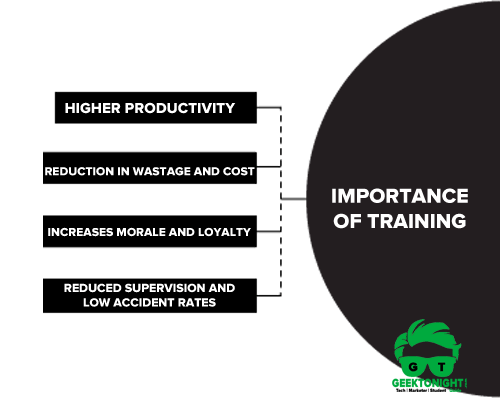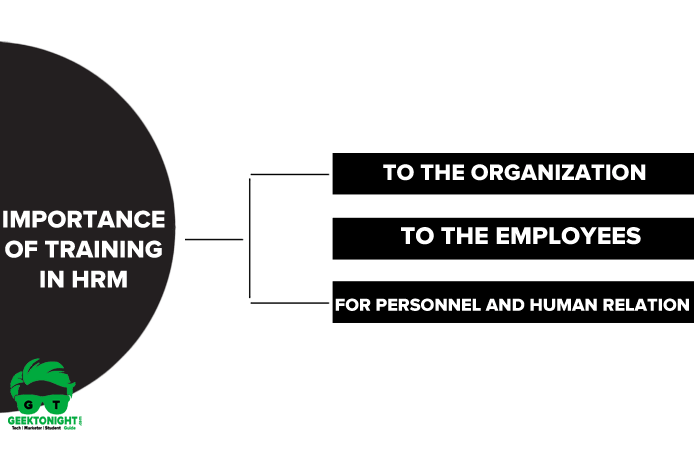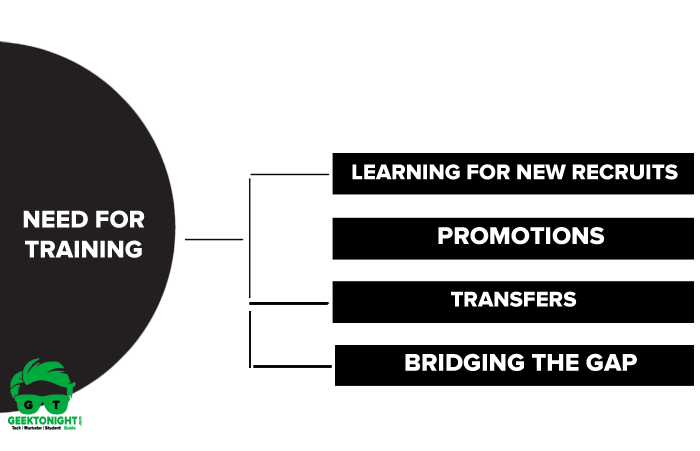Training is a very important tool in all the departments of the business e. g. finance, production, marketing, etc. The return on investment in training is huge in terms of higher productivity, enhancing the skills of the employees, increasing the motivation levels, etc.
Table of Content
Importance of Training
Adequately planned and well-executed training program can lead to the following advantages.
Importance of Training are:
- Higher productivity and better quality of work
- Reduction in wastage and cost
- Increases morale and loyalty
- Reduced supervision and low accident rates

Higher productivity and better quality of work
Formal training leads to the enhancement of skills of the employees that enables them to perform their job more efficiently. As standard methods are taught to the employees it improves the quality of product and services.
Reduction in wastage and cost
Workers learn how to make the optimum use of resources. Training leads to the economic use of material and machinery and helps minimize the cost of operations per unit.
Increases morale and loyalty
Training helps boost the morale of the employees by developing a positive attitude, job satisfaction and enhanced learning. It makes them loyal to the organization as they develop a sense of commitment.
Reduced supervision and low accident rates
Training develops well-motivated employees who are self-reliant, they do not need constant guidance and supervision. Employees can also avoid mistakes and accidents on the job as they can handle a job with confidence and adopt the right work methods
Importance of Training in HRM

To the Organization
- Gets more effective in decision-making and problem-solving.
- Improve the morale of the workforce.
- Helps people identify the organizational goal.
- Aids in developing leadership skills, motivation, loyalty and better attitude.
- Aids in improving productivity and quality of work.
- Aids in understanding and carrying out organizational policies.
- Aids in organizational development.
- Creates an appropriate climate for growth and communication.
- Helps employees adjust to change.
To the Employees
- Increases job satisfaction and recognition
- Moves a person towards personal goals while improving skills
- Helps in eliminating the fear of attempting new tasks
- Provides the trainee with an avenue for growth
- Through training and development, motivational variables of recognition, achievement growth, responsibility and advancement are internalized and operationalised
- Provides information for improving leadership, communication skills and attitudes
- Helps to handle stress, tension, frustration and conflict
For Personnel and Human Relation
- Improve inter-personnel skills
- Improves morale
- Builds cohesiveness in groups
- Makes the organization a better place to work and live
- Provides information on other governmental laws and administrative policies.
Need for Training
Training is required for organizational growth. It is beneficial to both the employer and the employee; it makes the employee more efficient which leads to better results and growth of the organization.

Learning for New Recruits
Once the employees are selected and placed in a position they need to be trained for a specific job. It helps in making them perform their job effectively. On job training help them handle their job competently.
Promotions
In order to prepare the existing employees for higher roles they need to be trained in the areas of their added responsibilities so that they can do justice to the position.
Transfers
Training on different jobs makes the employees mobile and versatile and makes them capable to be moved from one job to another.
Bridging the Gap
There can at times be some gaps between the knowledge and skills an employee possesses and the requirements of the job. Training helps in bridging this gap and making the employees more productive.
Benefits of Training
| SNO | Benefits to the Business | Benefits to the Employee |
|---|---|---|
| 1 | Trained people can work more efficiently | It makes an employee more useful to the firm. |
| 2 | They use machines, tools materials in a proper way. Wastage is thus eliminated to a large extent. | It makes employees more efficient and effective. They produce more with minimum effort. |
| 3 | There are fewer accidents. | It enables employees to secure promotion easily. They can realize their career goals comfortably. |
| 4 | They show superior performance. | They can handle jobs with confidence. They are more satisfied on their jobs. Their morale would be high. |
| 5 | It makes employees more loyal to an organisation. They will be less inclined to leave the unit where there are growth opportunities. | It can enable employees to cope with organisational, social and technological change. Effective training is an invaluable investment in the human resource of an organisation. |
Reference
- R. P. Lynton, U. Prateek, “Training for Development”, Sage Publications 2002.
- Goldstein, “Training in Organizations”, Burr Ridge: McGraw Hill, Irwin, 1999
- Fitzgerald, W. (1992). Training versus development. Training and Development, 46(5), 81-84.
Go On, Share article with Friends
Did we miss something in Human Resource Management Tutorial? Come on! Tell us what you think about our article on Importance of Training in the comments section.
Human Resources Tutorial
(Click on Topic to Read)





